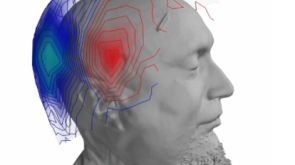
Norberto Grzywacz, specialist in the brain mechanisms of aesthetic values
During his sabbatical year in France, Norberto Grzywacz is hosted by the Laboratoire des Systèmes Perceptifs at the ENS-PSL. His research focuses on the brain mechanisms of aesthetic values. Why do people perceive certain visual scenes and auditory pieces as beautiful or ugly? This work has led him to the fields of perception and art.
The brain mechanisms of aesthetic values
 Norberto Grzywacz and his team view their work as an investigation of the brain mechanisms underlying human values. "Values are essential components of how humans and other animals make decisions about how to act. Aesthetic values are one component of the brain’s value system and we have focused mostly on them because of their experimental and theoretical accessibility." Beauty and ugliness are part of a spectrum of decisions made with the help of aesthetic values for evolutionarily important tasks. "Whether you will eat that apple or decide to date that person depends in part on your aesthetic values." says the scientist.
Norberto Grzywacz and his team view their work as an investigation of the brain mechanisms underlying human values. "Values are essential components of how humans and other animals make decisions about how to act. Aesthetic values are one component of the brain’s value system and we have focused mostly on them because of their experimental and theoretical accessibility." Beauty and ugliness are part of a spectrum of decisions made with the help of aesthetic values for evolutionarily important tasks. "Whether you will eat that apple or decide to date that person depends in part on your aesthetic values." says the scientist.
But what are the brain mechanisms underlying the decision that something is beautiful or ugly? Research has revealed that although aesthetic values are individual and thus somewhat subjective, the way that the brain processes them is objective. Several areas of the brain participate. "The four most important areas for aesthetic values are the Orbitofrontal Cortex, Basal Ganglia, Anterior Insula, and Rostral Cingulate. Each of these areas has a relatively well understood function, allowing us to formulate hypotheses and probe the processes involved in aesthetic values. For example, the Basal Ganglia is important in their learning, enabling each of us to adapt them to our unique contexts, such as environments, families, societies, and cultures."
Therefore, differences between individuals in their decisions of beauty and ugliness is in part due to learning mechanisms operating in different contexts. "Individuality also arises from signals from inside our bodies received by the Anterior Insula. Because we have different metabolisms, sex drives, fear of risks, and so on, we act differently and thus learn individualized set of values." However, values, beauty, and ugliness are not entirely individual. "Nature and societies impart values that are similar across peers. For example, that symmetry tends to have high aesthetic value is common across cultures because important biological features, such as faces, fruits, and body plants are symmetrical. Hence, during evolution, specialized mechanisms for symmetry processing emerged, making it a component of our aesthetic-value system."
Neuroscientific studies of large paintings and popular music
The research of Norberto Grzywacz and his team on the cerebral mechanisms of aesthetic values naturally led them to the arts. "We have interest to probe whether one can see signatures of what we have been uncovering in the brain in the work of painters, musicians, and architects." It is not surprising that the researcher's team is highly multidisciplinary, bringing together painters, musicians and architects, scientists, engineers, mathematicians, psychologists and sociologists.
"Our main exploration tool in this front has been the statistics of art pieces such as portrait paintings and popular songs. Moreover, we have been testing experimentally whether the conclusions from these statistical studies apply to non-artist observers. Some of these conclusions include the competition between aesthetic variables in the brains of artists and the importance of musical surprise."
Another important conclusion is the tendency of artists to exaggerate the value of aesthetic variables. "This conclusion is important because it implies that art is generally not a faithful representation of external truth, but instead exaggerates certain properties for aesthetic effects." Thus, art tickles the areas of the brain involved in evolutionary important aesthetic-value-based decisions. "Importantly, these values are not fixed. They drift in individuals over the course of minutes to years. And when focusing on the history of art, we have observed drifts in the values of aesthetic variables over the course of centuries. But we have also observed phase transitions in the history of art in the span of only a couple of decades."
A sabbatical year to develop a new line of research
This sabbatical year allows the researcher to deepen his work and to develop a new line of research. "The main new idea that I hope to develop this year is a study of how aesthetic cultures emerge from the social interactions between people. Preliminary results suggests that when different individuals with the learning mechanisms that I describe above interact with each other, groups of similar aesthetic values begin to form. These groups give rise to aesthetic cultures."
Throughout his stay in France, the researcher will participate in seminars, workshops, and conferences at the ENS but also at the IRCAM (Institute for Research and Coordination of Acoustics and Music) or will participate in July in the summer colloquium "Beautés Vitales: Pour une Approche Contemporaine de la Beauté" (Vital Beauties: For a Contemporary Approach to Beauty) at the Centre Culturel International de Cerisy.
The LSP, an ideal environment for research in visual and auditory neuroscience
The research conducted at the LSP made it an ideal environment for Norberto Grzywacz who was familiar with the work of Pascal Mamassian, director of the laboratory, in the field of visual cognitive neuroscience. "In my opinion, Pascal Mamassian was one of the best scientists in the world in the field of visual cognitive neuroscience. I also felt that the way Pascal thought about theories of the cognitive brain was like how I did. Besides Pascal, the LSP had many other visual scientists with whom I felt academic affinity, including Peter Neri and Claudia Lunghi."
The presence of a team specializing in auditory neuroscience at the LSP also allows the researcher to discuss his work on musical aesthetic values. More generally, the multidisciplinary nature of the DEC was a determining factor in his choice to spend part of his sabbatical year at the ENS. Finally, the opportunity to spend time in the French capital was a decisive factor. "Paris, the "City of Art", is one of the few places in the world where I can interact with large communities interested in music, architecture, and visual arts. With the size and diversity of these communities, the chances of finding people interested in collaborations with scientists increases dramatically."
Norberto Grzywacz will take advantage of his long stay to travel through France, and visit in particular the prehistoric sites of the Vézère Valley in Dordogne, to discover caves decorated with prehistoric paintings. "Is this surprising for a scientist interested in art?" he concludes with humor!
TO LEARN MORE



